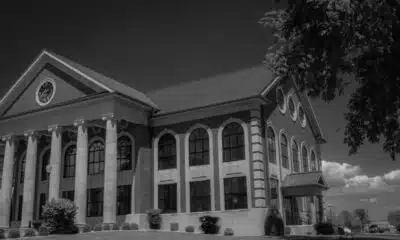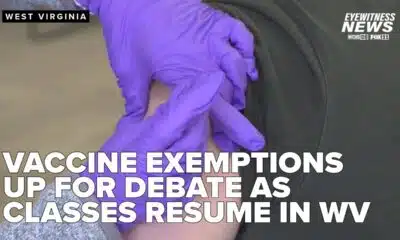News from the South - Texas News Feed
Hill Country flooding: Here’s how to give and receive help
“Hill Country flooding: Here’s how to give and receive help” was first published by The Texas Tribune, a nonprofit, nonpartisan media organization that informs Texans — and engages with them — about public policy, politics, government and statewide issues.
Sign up for The Brief, The Texas Tribune’s daily newsletter that keeps readers up to speed on the most essential Texas news.
The Texas Hill Country is reeling after a devastating flood with a confirmed death toll of 43 as of Saturday afternoon. The Kerr County’s sheriff’s office said the victims include 28 adults and 15 children.
Rescue efforts are still underway as authorities search for 27 girls who went missing from Camp Mystic, a long-running Christian camp. With families turning to social media for answers, officials warn the full scope of the disaster may not be known yet.
Texas still faces flood threats as officials warn caution. Saturday’s forecast predicts 2-4 inches of rain, with isolated areas potentially receiving up to 10 inches per the National Weather Service.
As rescue efforts continue in Kerrville, questions are arising about how to assist those affected by the flood. Here is a guide on how you can help those in need, along with safety tips for dealing with flood warnings and what to do when you encounter flood waters.
How to help Texans affected by the floods
The Kerr County Flood Relief Fund has been set up to help those impacted by the floods.
The fund was created by The Community Foundation of the Texas Hill Country, a 501(c)(3) charity, that will be directing money to “vetted organizations providing rescue, relief, and recovery efforts as well as flood assistance,” according to its site.
Additionally, Southern Oaks Church is organizing a supply drive to support those impacted. Church officials urged locals to stay off the roads today but are encouraging people to start gathering items from home. Supplies can be dropped off at 122 Valley View in Kerrville.
They are looking for hygiene kits, baby and child essentials, clothing, food and nutrition, comfort and coping materials and more.
For those who live far away, the church has set up an online donation on its site. Select “River Flood Relief Fund” to donate to flood victims.
Austin’s Jester King Brewery is collecting items as well. Materials can be dropped off on Saturday or Sunday at their address: 13187 Fitzhugh Rd in Austin. Materials will be dropped off at Cross Kingdom Church.
Items most in need are bottled water, non-perishable food, new socks and underwear, kids clothing, diapers and baby wipes, flashlights and batteries, toiletries and cleaning supplies and pet food.
Treaty Oak Distillery in Dripping Springs is also taking donations. The address is 16604 Fitzhugh Rd in Dripping Springs. They are looking for cleaning and recovery supplies, food and water, emergency supplies, personal hygiene products, tools and more.
TEXSAR, an Austin-based nonprofit specializing in emergency response, has deployed swiftwater rescue teams, boats, drones and search dogs to aid in the search for the missing. The group is aiming to raise $100,000 to sustain its efforts. Donations can be made online.
The Salvation Army’s Kroc Center in Kerrville is collecting nonperishable food, diapers, and cleaning items like bleach, trash bags, brooms and shovels. Donations can be dropped off at its Social Services office, located at 855 Hays Street in Kerrville.
How to get recovery assistance
Cross Kingdom Church in Kerrville has received many donations, and church officials said people can come by and grab things. The address is 3044 Junction Hwy in Kerrville.
Texans who sustained damage caused by the storms are encouraged to report it through the Individual State of Texas Assessment Tool.The tool helps emergency management officials understand the scope of the damage, which can influence emergency declarations and federal spending.
If you are impacted by a natural disaster, government services and community resources are available to help you with recovery.
Organizations like the American Red Cross, Salvation Army and local volunteer organizations can help you find food, shelter and supplies, as well as assist you with clean-up efforts. Texas Health and Human Services is responsible for coordinating efforts to help Texans in need immediately after a widespread emergency.
After a disaster, a state’s governor can issue a disaster declaration, asking the president to declare an emergency or major disaster, which then frees up federal funds to help those affected. The Federal Emergency Management Agency provides disaster assistance in these situations.
Before applying for assistance from FEMA, insured Texans should first file claims through their existing policies. People cannot receive disaster and insurance assistance for the same damages. Doing so would be considered insurance fraud, according to FEMA.
If you need to file an insurance claim because your home or property was damaged, call your insurance company to report the damages and be ready to answer questions about how you were impacted. Be sure to take photos and videos to submit to insurance or FEMA and document damages for your records.
If you need help quickly, you can ask your insurance company about an advanced payment. If you aren’t able to live in your home after the disaster because of extensive damage, most policies will cover some housing costs, according to the Texas Department of Insurance, so be sure to keep your receipts.
If you need help filing a claim, TDI has a helpline that operates Monday to Friday, from 8 a.m. to 5 p.m. Central Time. Texans can call 800-252-3439 to find out contact information for their insurance company and ask any questions about claims.
The State Bar of Texas also offers a toll-free legal hotline to assist low-income Texans with issues like replacing lost documents, insurance questions, landlord-tenant problems, price-gouging or avoiding contractor scams following a natural disaster. Residents can call 800-504-7030, which is answered in English, Spanish and Vietnamese. Those who qualify for assistance are matched with Texas lawyers who can provide free, limited legal help, according to the state bar’s website.
Here’s what to do in case of flooding:
- Follow evacuation orders from local authorities and take an emergency kit with you.
- Avoid walking or driving through flood waters. Just six inches of water can make a person fall, while one foot of water is enough to sweep up a vehicle during a flood.
- If flood waters rise around your vehicle, leave it and move to higher ground. If you are stuck in a flooded area, look for a higher space away from flood waters. Stay off bridges that go over fast-moving water. You can check for flooded or closed roads through the state’s drivetexas.org website.
- Be careful in areas where flood waters have receded and watch out for debris or electrically charged standing water. Stay away from all bodies of water and electric lines near you.
- Shut off your home’s main circuit breakers to prevent appliance short circuits and the threat of electrocution.
- Make a plan for your pets and take them with you in case of an evacuation.
How to set up emergency alerts
To know when a weather emergency is expected or to stay updated during a disaster, sign up for emergency alerts from your city or county. Residents can look up their county emergency management office online to sign up for emergency emails and texts.
Texans who rely on electricity for medical reasons can apply for chronic conditions or critical care status, which provide extra notifications ahead of interruptions or suspensions of service. Applications have to be approved by a physician and submitted to the transmission and distribution utility that covers your address. The status doesn’t guarantee uninterrupted power, so if electricity is a necessity, make other arrangements ahead of a storm if possible.
Texans with disabilities or people who would require additional medical assistance during an emergency can also sign up for the State of Texas Emergency Assistance Registry, a free system run by the state that gives emergency responders additional information about the communities they are helping in the aftermath of a natural disaster.
Major phone providers participate in the federal wireless emergency alert system, which enables federal, state and local authorities to broadcast alerts to mobile devices. Check the settings on your phone to ensure you have these alerts turned on. They are often labeled “Government Alerts” or “Emergency Alert Messages.”
If you need to find community resources during a disaster, dial 2-1-1 or 877-541-7905 for information about resources including food, health, housing and more.
How to get mental health support
It is normal for people to experience shock in the immediate aftermath of a disaster. People like those with existing mental health conditions may see increased symptoms of stress. Others may focus on recovery and relief efforts but may feel symptoms of stress and trauma later on, according to experts.
Symptoms can include aches, trouble sleeping, changes in appetite, losing motivation, getting frustrated more frequently and feeling overwhelmed, sad, numb, lonely and physically or mentally drained.
Most emotional responses and stress symptoms are temporary, but if they persist for two weeks or longer, it is recommended to seek help. Signs of greater emotional distress can include feeling hopeless, feeling guilty without being sure why, having difficulty readjusting to home and work life, excessive smoking, drinking or drug use or thinking of hurting yourself or someone else, according to the federal Substance Abuse and Mental Health Services Administration (SAMHSA).
SAMHSA runs the Disaster Distress Helpline, which provides support to people experiencing emotional distress related to disasters. The helpline operates year-round, 24 hours a day and is free and confidential. You can call or text 800-985-5990 to be connected with a trained crisis counselor who can provide counseling, healthy coping tips and more information on signs of emotional distress. Crisis counselors can also provide local resources for additional support.
Trained crisis counselors are also available through the national Suicide and Crisis Lifeline by calling or texting 988.
Read more tips about how to take care of your mental health during natural disasters here.
Shape the future of Texas at the 15th annual Texas Tribune Festival, happening Nov. 13–15 in downtown Austin! We bring together Texas’ most inspiring thinkers, leaders and innovators to discuss the issues that matter to you. Get tickets now and join us this November.
TribFest 2025 is presented by JPMorganChase.
This article originally appeared in The Texas Tribune at https://www.texastribune.org/2025/07/05/texas-hill-country-flooding-how-to-help/.
The Texas Tribune is a member-supported, nonpartisan newsroom informing and engaging Texans on state politics and policy. Learn more at texastribune.org.
The post Hill Country flooding: Here’s how to give and receive help appeared first on feeds.texastribune.org
Note: The following A.I. based commentary is not part of the original article, reproduced above, but is offered in the hopes that it will promote greater media literacy and critical thinking, by making any potential bias more visible to the reader –Staff Editor.
Political Bias Rating: Centrist
The content presents straightforward information about various community and nonprofit efforts to support flood relief in Kerr County, Texas. It neutrally reports on charitable organizations, churches, businesses, and emergency response groups organizing donations and aid without any ideological language or political framing. The article focuses on practical assistance and community response, maintaining an objective tone and avoiding partisan or controversial viewpoints. As such, it adheres to neutral, factual reporting with no discernible political bias.
News from the South - Texas News Feed
Abrego Garcia released from prison, headed to family
SUMMARY: Kilmar Abrego Garcia, wrongfully deported and imprisoned, has been released from a Tennessee jail and is en route to Maryland to reunite with his family, his lawyer Sean Hecker confirmed. Abrego Garcia was deported in March due to an “administrative error” and faced federal human smuggling charges related to a 2022 Tennessee traffic stop. His attorneys argue the prosecution is vindictive and selective, citing violations of his due process rights. A 2019 immigration ruling bars his return to El Salvador, and ICE is restricted from immediate custody post-release. The case continues amid concerns over potential re-deportation.
The post Abrego Garcia released from prison, headed to family appeared first on www.kxan.com
News from the South - Texas News Feed
Texas Senate expected to take up GOP congressional map
“Texas Senate expected to take up GOP congressional map, last stop before Abbott’s desk” was first published by The Texas Tribune, a nonprofit, nonpartisan media organization that informs Texans — and engages with them — about public policy, politics, government and statewide issues.
Sign up for The Brief, The Texas Tribune’s daily newsletter that keeps readers up to speed on the most essential Texas news.
The Texas Senate on Friday was expected to consider a new congressional map gerrymandered to maximize Republican representation, putting the plan on a path to the governor’s desk after weeks of intense partisan clashing.
Republican lawmakers were poised to push the map through over fierce Democratic opposition, launching a national redistricting war from Albany to Sacramento while positioning the GOP to net up to five additional seats in Texas.
The map, demanded by President Donald Trump to fortify the GOP’s U.S. House majority in next year’s midterm election, would hand up to five additional U.S. House seats to Republicans by dismantling Democratic bastions around Austin, Dallas and Houston, and by making two Democrat-held seats in South Texas redder. The new lines would also keep all 25 seats already held by Republicans safely red.
The pickups are meant to help the GOP hold onto its razor-thin congressional majority in a midterm election year that is expected to favor Democrats — potentially making the difference between a continued Republican trifecta in Washington, or a divided government with one chamber intent on investigating Trump and bottlenecking his agenda.
That has put Texas lawmakers at the front lines of an issue with national stakes. Republicans earned kudos from Trump for pushing the new boundaries through the state House, while Democrats won support from national party figures, including former President Barack Obama, Democratic National Committee Chair Ken Martin and U.S. House Minority Leader Hakeem Jeffries of New York.
Though congressional lines are typically redrawn once every 10 years following the decennial census, Republicans justified the aggressive and unusual move to do so in the middle of the decade by saying it was legal to craft new boundaries at any point and for purely partisan gain. They also pointed to the party’s margins of victory in 2024 and the need to counter blue-state gerrymandering to further support their push.
The U.S. Supreme Court ruled in 2019 that states can draw electoral maps on partisan grounds. But under Section 2 of the Voting Rights Act, the lines cannot diminish people’s voting power based on race.
Democrats argued that the new map would increase Republicans’ advantage by unconstitutionally suppressing the vote of Black and Latino Texans. They framed the push as a power grab by Trump meant to stack the deck in next year’s election.
Texas’ anticipated approval of the map has set off a tit-for-tat redistricting push in California, where Gov. Gavin Newsom has proposed a map voters would have to approve that could yield five new Democratic-leaning seats, effectively offsetting GOP gains in Texas. Other blue-state governors and national Democratic leaders are backing retaliatory gerrymandering as the Trump administration also pushes GOP-controlled Florida, Indiana, Missouri and Ohio to draw more red seats.
The new Texas map cleared its biggest hurdle Wednesday when, after more than eight hours of tense debate, the state House adopted the plan along party lines.
Lacking the votes to stop the map in the GOP-dominated Texas Legislature, more than 50 House Democrats staged a two-week walkout earlier this month, grinding the lower chamber to a halt by denying the quorum needed to conduct business.
Republicans unleashed an unprecedented response to drag them back to Texas, issuing civil arrest warrants, asking a court to extradite them from Illinois, seeking to declare over a dozen Democrats’ seats vacant and clamoring for legislative punishments upon their return.
After most Democratic lawmakers returned to Austin Monday, Republican Speaker Dustin Burrows, seeking to maintain a quorum, required each of them to agree to a police escort to leave the Capitol building. Rep. Nicole Collier, D-Fort Worth, refused and was confined to the Capitol for the next 54 hours, prompting a national media frenzy.
Democrats portrayed the walkout as a victory for sparking a national movement in support of retaliatory redistricting, and as just the first part of a longer fight against the map. In the House on Wednesday, Democratic lawmakers pressed their Republican colleagues on the plan’s impact on voters of color, working to establish a record they could use in a legal challenge seeking to kill the lines before next year’s election.
“This fight is far from over,” Rep. Gene Wu of Houston, chair of the House Democratic Caucus, said after the map’s passage in the lower chamber. “Our best shot is in the courts. This part of the fight is over, but it is merely the first chapter.”
More all-star speakers confirmed for The Texas Tribune Festival, Nov. 13–15! This year’s lineup just got even more exciting with the addition of State Rep. Caroline Fairly, R-Amarillo; former United States Attorney General Eric Holder; Abby Phillip, anchor of “CNN NewsNight”; Aaron Reitz, 2026 Republican candidate for Texas Attorney General; and State Rep. James Talarico, D-Austin. Get your tickets today!
TribFest 2025 is presented by JPMorganChase.
This article originally appeared in The Texas Tribune at https://www.texastribune.org/2025/08/22/texas-congressional-redistricting-map-senate-governor-desk/.
The Texas Tribune is a member-supported, nonpartisan newsroom informing and engaging Texans on state politics and policy. Learn more at texastribune.org.
The post Texas Senate expected to take up GOP congressional map appeared first on feeds.texastribune.org
Note: The following A.I. based commentary is not part of the original article, reproduced above, but is offered in the hopes that it will promote greater media literacy and critical thinking, by making any potential bias more visible to the reader –Staff Editor.
Political Bias Rating: Center-Left
The article focuses on the Texas congressional redistricting map, highlighting its Republican origins and the partisan conflict it has sparked. It provides detailed coverage of Democratic opposition and criticisms, including concerns about voter suppression among minority groups, and frames Republican efforts as a “power grab” led by Trump. The inclusion of national Democratic figures’ support for opposition and the emphasis on Democratic strategies and responses suggest a slight lean toward a Center-Left perspective. However, the article maintains a measure of balance by covering Republican justifications and legal points, which keeps it from tilting strongly left or right.
News from the South - Texas News Feed
Dinosaur teeth reveal secrets to Earth's past, UT study finds
SUMMARY: A University of Texas study analyzed dinosaur teeth fossils from the late Jurassic period to uncover their diets and behaviors. Paleontologist Liam Norris examined calcium isotopes in teeth from herbivores like Diplodocus, Camarasaurus, and Camptosaurus, revealing varied feeding habits such as ground-level and canopy browsing, with each species targeting different plants to coexist. Carnivores like Allosaurus mainly consumed flesh, avoiding bones, while Eutretauranosuchus likely ate fish. The research shows dinosaurs couldn’t chew but swallowed food whole, aiding new understanding of ancient ecosystems. This study enriches paleontology, offering deeper insights into dinosaur life and evolution.
The post Dinosaur teeth reveal secrets to Earth's past, UT study finds appeared first on www.kxan.com
-
News from the South - Texas News Feed6 days ago
New Texas laws go into effect as school year starts
-
News from the South - Florida News Feed6 days ago
Floridians lose tens of millions to romance scams
-
News from the South - Kentucky News Feed7 days ago
AmeriCorps is under siege. What happens in the communities it serves?
-
News from the South - Florida News Feed7 days ago
Protesters go on strike in Israel demanding ceasefire and release of Gaza hostages
-
News from the South - West Virginia News Feed5 days ago
Religious exemption debate front and center amid new school year in WV
-
News from the South - Arkansas News Feed5 days ago
Trump, Zelenskyy exit White House talks hopeful about security guarantee for Ukraine
-
News from the South - Alabama News Feed6 days ago
Final steel girders placed on new Gulf Shores bridge, completion on track
-
News from the South - Tennessee News Feed6 days ago
Son hopes to get emergency visa following mother's death in East Tennessee















































